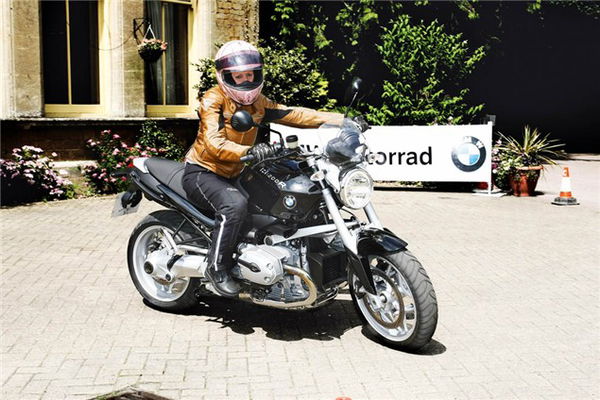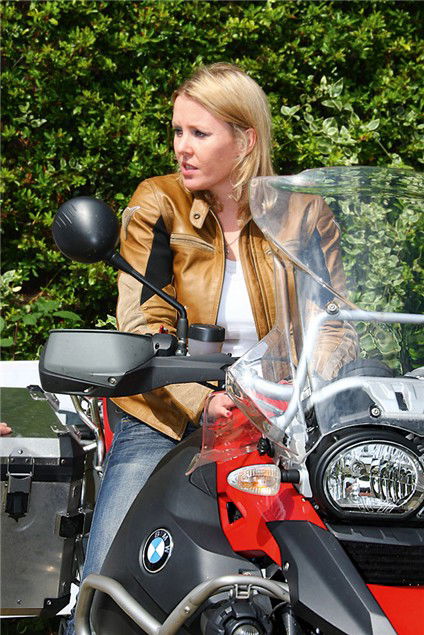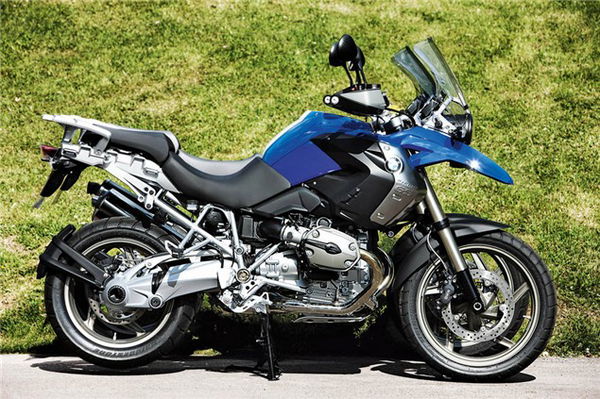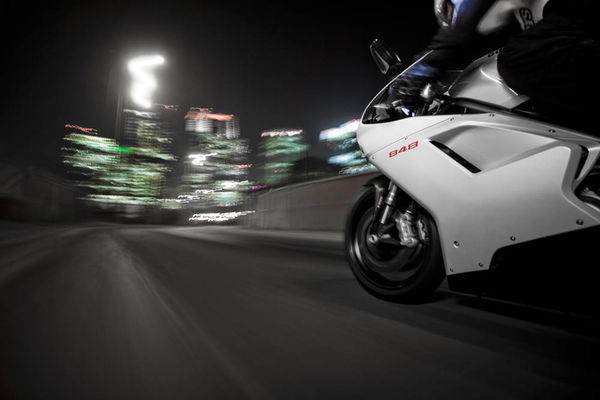BMW's Big bikes for little people
BMW are now offering a large proportion of their bigger models with lowered saddles and shocks for those of a shorter stature. TWO sent a tiny person to investigate
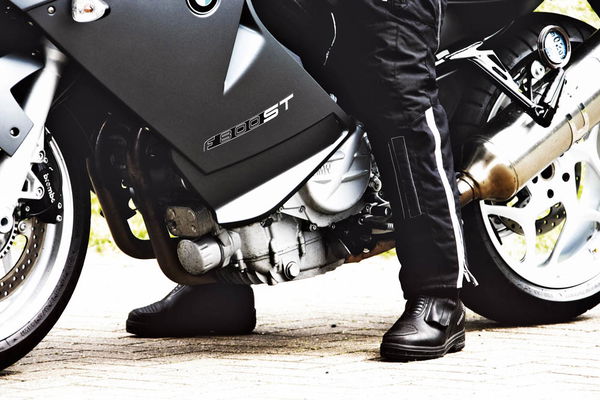
height=10> | |
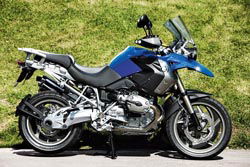 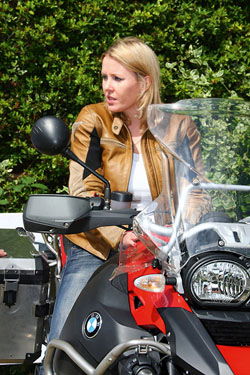 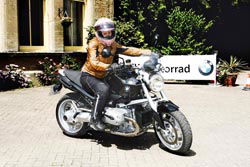 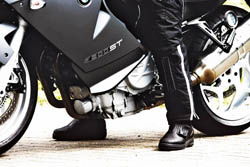 It struck me like an epiphany the first time I realised that motorcycling was an achievable and open world for me. I was sat on a superbike in Battersea Park, London, with both feet flat (almost) on the ground. With my 5ft 3 (and three-quarters, those three-quarters are very important) frame I’d always struggled in the past, but here was a bike that not only could I fit on but was fast, light and manouverable into parking bays. It was perfect, it was a silver and black Yamaha R1 and I didn’t even have my licence. Anyone who’s a little bit on the shorter side like me but loves their bikes knows exactly how this feels. There have been so many concerns associated with getting my feet down over the years including gravel, damp leaves, off camber roads, pot holes, steep descents, stopping at car park barriers and getting tickets out that some of these have had a major affect on my confidence. And as such it has probably taken me far longer to learn to ride well than taller riders will have done. My journey through motorcycling has always been one of compromise. I glance enviously at the orange aggressive streaks snarling up the asphalt around me - I long to be able to ride a KTM without needing a step ladder at every set of lights and I watch travel shows with luminous envy at intrepid explorers on their laden off-road motorcycles globe trotting through otherwise unreachable destinations. I want to experience all that the two-wheeled world can offer, but too many times in the past the doors have remained shut because of my height. Or lack of it. But this being 2008, it seems rather archaic that biking should be the recluse of only taller people. And it seems that BMW agree with me. It’s always been possible to lower the suspension of a bike, but the compromise betwixt handling and ground clearance have been unpredictable and generally a hit and miss affair. BMW are the first, and currently only, manufacturer to offer factory-lowered suspension across a significant proportion of their range. Previously only available on the 650GS, lowered Beemers are now available on their best-selling and larger models including the F800S, F800ST, R1200R, R1200GS and R1200RT which reflects 50% of their total sales. BMW are big on selling optional extras and the ability to slam your Beemer to the floor may be the deciding factor in purchasing a bike that would have otherwise have been well beyond your inner thigh. Europeans in general are a lofty bunch and BMW’s strong domestic market meant that when they were designing their motorcycles, seat height wasn’t a huge concern. But the growth of their international market has highlighted the issue with their lofty mounts, some of which are understandably lanky with long-travel suspension, but others are just plain…fat. Because it’s not just seat height that determines your ability to reach the ground in comfort, it’s also how skinny or wide a bike is in the saddle area. Hondas and Suzukis have always been a bit chubby here while Yamahas and Ducatis tend to be slim. BMW have focused on this measurement that they call the ‘inseam dimension’ which takes account of legroom for riding, knee angle and seating comfort. The factory-lowered suspension isn’t just about a shorter shock at the rear or a thinner seat as it has been in the past. On these new BMWs both front and rear shocks are new, shock lengths and linkage are altered and with some change to the internals of the fork sliders, and it’s possible to lose up to 55mm through just the suspension, more with a low seat option thrown into the mix. This will only set you back £90 and while these kits won’t be retro fitted, the parts will be available to purchase. The lowered suspension is a noticeably harder ride than stock, obvious really with the reduced shock travel but possibly a margin more than I expected it to be. Take the entry level 650GS: while being able to reach the ground on the ‘normal’ model, I did have better foot-paddling ability and certainly would have been more confident on this if I had a pillion lurching from side to side. The handlebars feel slightly unnatural at first, as if I was reaching up to them and as such the bike initially feels slightly less in control at speed as I like to be positioned firmly in command, ‘on top’ of my bikes. If I hadn’t had the standard model right next to me for comparison this probably wouldn’t have been noticeable. Apart from the very real issue with actually getting your feet to reach the ground, the benefit of the lowered suspension is really in the inspired confidence that you could just get away with a lot more when riding and have fewer near misses in the memory bank or actual embarrassing drops. Riding bikes well is all about confidence, and the lowered BMWs allowed me to explore and push my own limits comfortably inside my personal safety zone. Faced with a coned car park and the challenge of tight figure-of-eights I would always choose a scooter to tackle this obstacle and staring at this after breakfast I did have a moment of cold sweat. But with the lowered suspension I had a chance of rescuing any wobbly moments. And for the most part I did, even the larger capacity bikes were significantly more manageable and I was riding better and more confidently than I would have done on their counterparts. Even when I did drop the R1200R it’s important to note that I almost managed to save it, with my feet paddling beneath to save it. I’m ashamed to say I couldn’t pick it up by myself, though! With the slow-speed handling point proved (and my ego only slightly battered) the Cotswold’s finest roads beckoned, and we escaped into the basking rays of a glorious summers day. None of the bikes felt compromised on rider position and the ergonomics seemed to work even better over longer distances. In town or on the open road none of them felt unwieldy as I had expected the weighty BMWs to feel and it simply didn’t occur to me that I was riding a range of traditionally heavy motorcycles. For a small person, this is a revelation. If you’d told me a week ago that I would be bowling along on a 1200R and not panicking at every set of lights, I’d have laughed at you. “No way, just not possible,” I’d have said. But here we were, and loving how neutral and completely manageable 300kgs of bike and rider felt. In fact I felt so comfortable that I attempted to reverse some old habits. Having always been a right foot down type of girl, it was advised that I should actually be putting my left foot down at lights so I could complete my braking with the rear brake. It felt as awkward as patting my head and rubbing my stomach at the same time. Approaching a series of small roundabouts in a market town proved a fumbling challenge, having to tackle the alien indicators on an alien bike with the wrong (to me) foot on the ground repeatedly. Considering my car park experience earlier it could have all been an embarrassing incident played out before the eyes of the Gloucesteshire gentry. However it was here that the lowered suspension aspect was an absolute gem, not only could I now ride motorcycles previously out of range but within a matter of minutes felt confident enough to play about on them, move my body weight around, bounce from foot to foot, momentarily forgetting my new left foot down technique by the distraction of a cream tea shop. The bikes felt easy, and jumping from one model to another without hesitation to repeatedly blast through and around the sun baked rolling hills of England provided a top day’s riding. At times exhilarating, like the discovery of the gutsy availability of power on the R1200R, at times satisfying, getting a series of perfect placement twists and turns on the F800ST, but most of all fun. And that, no matter what your motorcycling ability or stature, is what motorcycling should be about. With all the lowered bikes I could fully reach the ground – previously unheard of for me. It was only the R1200GS that I still struggled to get off the side stand, not so much to do with seat height but more to do with the weight, centre of gravity and overall balance. On another day I might have given it more of a go but I just didn’t fancy dropping a second bike in front of everyone that day. The suspension kits install superior confidence, not a surprising revelation but I was really relieved that the inevitable compromises with handling and rider comfort were slight and on balance worth the pay off. If you aren’t able to reach the floor fully with your bike as it is then lowering it (BMW or otherwise) is definitely worth it, especially if you’re a novice or shorter than average ‘mostly in town’ rider with lots of stopping, starting and paddling around. The attention that BMW is paying to their suspension option is only part of their range, allowing you to have a bespoke riding experience, executed with the finest of German efficiency. If it brings you to motorcycles and experiences otherwise out of your reach, then that can only be a good thing. I for one have my world map open, and have started dreaming about ditching the day job and beginning my intrepid adventures on the back of a GS. Kensal Green one day, Dakar the next! For info on the lowered BMW range, visit your nearest dealer or www.bmw-motorrad.co.uk Tips For Hobbits:Apart from bike set-up there are several things you can do in your riding to make life a lot easier. Here are the top tips from Emmet Reidy, BMW Rider Training Chief Instructor, about the ever-dreaded slow speed riding to improve your skills and confidence: • Use your foot on the right peg as leverage when lifting the bike off the side stand, far less chance of it falling over the other side and helps lift heavier bikes. • Always use the rear brake to come to a stop when doing speeds of 5 mph or less, the front brake cuts speed down quickly but throws the bike off line, the rear brake keeps the bike in line and seated • 1st or 2nd gear not quite suitable? Slip the clutch and create any gear you like, be it turning round a cone in a car park or tackling an Alpine hairpin you can create any gear you like – think of it as 1.2, 1.4, 1.6… • When doing a U-turn set your revs and forget about them. Just make sure they’re high, all the forward motion should come from dragging the rear brake or slipping the clutch • When coming to a stop gently tug the right handle bar towards you causing the bike to fall onto your left foot. Ta-da! No need for double-stepping at the lights. |

It struck me like an epiphany the first time I realised that motorcycling was an achievable and open world for me. I was sat on a superbike in Battersea Park, London, with both feet flat (almost) on the ground. With my 5ft 3 (and three-quarters, those three-quarters are very important) frame I’d always struggled in the past, but here was a bike that not only could I fit on but was fast, light and manouverable into parking bays. It was perfect, it was a silver and black Yamaha R1 and I didn’t even have my licence. Anyone who’s a little bit on the shorter side like me but loves their bikes knows exactly how this feels. There have been so many concerns associated with getting my feet down over the years including gravel, damp leaves, off camber roads, pot holes, steep descents, stopping at car park barriers and getting tickets out that some of these have had a major affect on my confidence. And as such it has probably taken me far longer to learn to ride well than taller riders will have done.
My journey through motorcycling has always been one of compromise. I glance enviously at the orange aggressive streaks snarling up the asphalt around me - I long to be able to ride a KTM without needing a step ladder at every set of lights and I watch travel shows with luminous envy at intrepid explorers on their laden off-road motorcycles globe trotting through otherwise unreachable destinations. I want to experience all that the two-wheeled world can offer, but too many times in the past the doors have remained shut because of my height. Or lack of it. But this being 2008, it seems rather archaic that biking should be the recluse of only taller people. And it seems that BMW agree with me.
It’s always been possible to lower the suspension of a bike, but the compromise betwixt handling and ground clearance have been unpredictable and generally a hit and miss affair. BMW are the first, and currently only, manufacturer to offer factory-lowered suspension across a significant proportion of their range. Previously only available on the 650GS, lowered Beemers are now available on their best-selling and larger models including the F800S, F800ST, R1200R, R1200GS and R1200RT which reflects 50% of their total sales. BMW are big on selling optional extras and the ability to slam your Beemer to the floor may be the deciding factor in purchasing a bike that would have otherwise have been well beyond your inner thigh.
Europeans in general are a lofty bunch and BMW’s strong domestic market meant that when they were designing their motorcycles, seat height wasn’t a huge concern. But the growth of their international market has highlighted the issue with their lofty mounts, some of which are understandably lanky with long-travel suspension, but others are just plain…fat. Because it’s not just seat height that determines your ability to reach the ground in comfort, it’s also how skinny or wide a bike is in the saddle area. Hondas and Suzukis have always been a bit chubby here while Yamahas and Ducatis tend to be slim. BMW have focused on this measurement that they call the ‘inseam dimension’ which takes account of legroom for riding, knee angle and seating comfort. The factory-lowered suspension isn’t just about a shorter shock at the rear or a thinner seat as it has been in the past. On these new BMWs both front and rear shocks are new, shock lengths and linkage are altered and with some change to the internals of the fork sliders, and it’s possible to lose up to 55mm through just the suspension, more with a low seat option thrown into the mix. This will only set you back £90 and while these kits won’t be retro fitted, the parts will be available to purchase.
The lowered suspension is a noticeably harder ride than stock, obvious really with the reduced shock travel but possibly a margin more than I expected it to be. Take the entry level 650GS: while being able to reach the ground on the ‘normal’ model, I did have better foot-paddling ability and certainly would have been more confident on this if I had a pillion lurching from side to side. The handlebars feel slightly unnatural at first, as if I was reaching up to them and as such the bike initially feels slightly less in control at speed as I like to be positioned firmly in command, ‘on top’ of my bikes. If I hadn’t had the standard model right next to me for comparison this probably wouldn’t have been noticeable.
Apart from the very real issue with actually getting your feet to reach the ground, the benefit of the lowered suspension is really in the inspired confidence that you could just get away with a lot more when riding and have fewer near misses in the memory bank or actual embarrassing drops. Riding bikes well is all about confidence, and the lowered BMWs allowed me to explore and push my own limits comfortably inside my personal safety zone. Faced with a coned car park and the challenge of tight figure-of-eights I would always choose a scooter to tackle this obstacle and staring at this after breakfast I did have a moment of cold sweat. But with the lowered suspension I had a chance of rescuing any wobbly moments. And for the most part I did, even the larger capacity bikes were significantly more manageable and I was riding better and more confidently than I would have done on their counterparts. Even when I did drop the R1200R it’s important to note that I almost managed to save it, with my feet paddling beneath to save it. I’m ashamed to say I couldn’t pick it up by myself, though!
With the slow-speed handling point proved (and my ego only slightly battered) the Cotswold’s finest roads beckoned, and we escaped into the basking rays of a glorious summers day. None of the bikes felt compromised on rider position and the ergonomics seemed to work even better over longer distances. In town or on the open road none of them felt unwieldy as I had expected the weighty BMWs to feel and it simply didn’t occur to me that I was riding a range of traditionally heavy motorcycles. For a small person, this is a revelation. If you’d told me a week ago that I would be bowling along on a 1200R and not panicking at every set of lights, I’d have laughed at you. “No way, just not possible,” I’d have said. But here we were, and loving how neutral and completely manageable 300kgs of bike and rider felt
In fact I felt so comfortable that I attempted to reverse some old habits. Having always been a right foot down type of girl, it was advised that I should actually be putting my left foot down at lights so I could complete my braking with the rear brake. It felt as awkward as patting my head and rubbing my stomach at the same time. Approaching a series of small roundabouts in a market town proved a fumbling challenge, having to tackle the alien indicators on an alien bike with the wrong (to me) foot on the ground repeatedly. Considering my car park experience earlier it could have all been an embarrassing incident played out before the eyes of the Gloucesteshire gentry. However it was here that the lowered suspension aspect was an absolute gem, not only could I now ride motorcycles previously out of range but within a matter of minutes felt confident enough to play about on them, move my body weight around, bounce from foot to foot, momentarily forgetting my new left foot down technique by the distraction of a cream tea shop.
The bikes felt easy, and jumping from one model to another without hesitation to repeatedly blast through and around the sun baked rolling hills of England provided a top day’s riding. At times exhilarating, like the discovery of the gutsy availability of power on the R1200R, at times satisfying, getting a series of perfect placement twists and turns on the F800ST, but most of all fun. And that, no matter what your motorcycling ability or stature, is what motorcycling should be about.
With all the lowered bikes I could fully reach the ground – previously unheard of for me. It was only the R1200GS that I still struggled to get off the side stand, not so much to do with seat height but more to do with the weight, centre of gravity and overall balance. On another day I might have given it more of a go but I just didn’t fancy dropping a second bike in front of everyone that day.
The suspension kits install superior confidence, not a surprising revelation but I was really relieved that the inevitable compromises with handling and rider comfort were slight and on balance worth the pay off. If you aren’t able to reach the floor fully with your bike as it is then lowering it (BMW or otherwise) is definitely worth it, especially if you’re a novice or shorter than average ‘mostly in town’ rider with lots of stopping, starting and paddling around.
The attention that BMW is paying to their suspension option is only part of their range, allowing you to have a bespoke riding experience, executed with the finest of German efficiency. If it brings you to motorcycles and experiences otherwise out of your reach, then that can only be a good thing. I for one have my world map open, and have started dreaming about ditching the day job and beginning my intrepid adventures on the back of a GS. Kensal Green one day, Dakar the next!
For info on the lowered BMW range, visit your nearest dealer or www.bmw-motorrad.co.uk
Tips For Hobbits:
Apart from bike set-up there are several things you can do in your riding to make life a lot easier. Here are the top tips from Emmet Reidy, BMW Rider Training Chief Instructor, about the ever-dreaded slow speed riding to improve your skills and confidence:
- Use your foot on the right peg as leverage when lifting the bike off the side stand, far less chance of it falling over the other side and helps lift heavier bikes.
- Always use the rear brake to come to a stop when doing speeds of 5 mph or less, the front brake cuts speed down quickly but throws the bike off line, the rear brake keeps the bike in line and seated
- 1st or 2nd gear not quite suitable? Slip the clutch and create any gear you like, be it turning round a cone in a car park or tackling an Alpine hairpin you can create any gear you like – think of it as 1.2, 1.4, 1.6…
- When doing a U-turn set your revs and forget about them. Just make sure they’re high, all the forward motion should come from dragging the rear brake or slipping the clutch
- When coming to a stop gently tug the right handle bar towards you causing the bike to fall onto your left foot. Ta-da! No need for double-stepping at the lights.
